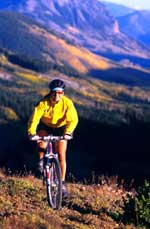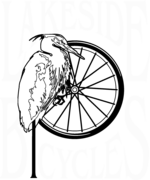BASIC TRAINING
 Bicycling has long been recognized as one of the finest forms of exercise. Unlike running, aerobics, Tae-Bo and other fitness fads, cycling is easy on the body because the bicycle supports your body weight so you don't have to. Plus, there's no impact on the body from pedaling.
Bicycling has long been recognized as one of the finest forms of exercise. Unlike running, aerobics, Tae-Bo and other fitness fads, cycling is easy on the body because the bicycle supports your body weight so you don't have to. Plus, there's no impact on the body from pedaling.
These advantages make cycling an ideal way to get fit because the risk of injury is practically nil and the chance of success is excellent. Even better, compared with stuffy health clubs or boring jogging tracks, every ride offers adventure. You enjoy overlooks, spot wildlife, conquer climbs, surf tailwinds, getting fit while having the time of your life.
In fact, cycling is such great fun, it's possible to get carried away and ride too far or too hard, too soon. That's probably not a problem if you're just riding for fun. But, if you're pedaling for fitness, it's wiser to build strength gradually and consistently according to a plan. To help, we offer the following 7 guidelines:
1) Get A Check-Up
Before beginning a fitness program it's best to get checked by your physician to ensure that it's safe for you to begin cycling regularly. Additionally, you can discuss your fitness goal with your doctor for expert feedback. She may surprise you with some excellent training tips!
2) Set A Goal
The secret to being motivated to train is having something to look forward to. For many riders it's an event such as a summer century (a 60- to 100-mile supported ride) or a mountain-bike festival (being fit means being able to keep up with others and finish rides). But, you might have less lofty goals, such as being able to make it up that long fireroad climb someday without walking. Whatever -- the goal you pick isn't as important as making sure that it's doable. For example, shooting for an Olympic medal is probably a stretch and setting yourself up for failure at the outset. It's more constructive and more motivating to choose goals within your reach. And you can always up the ante as you progress.
3) Work Then Rest
The basic principle of exercise is stressing the body a certain amount and then letting it recover. During the recovery phase the body reacts to the work you did and actually gets stronger. And, over time, by gradually increasing the amount and intensity of the work and recovering carefully, you build fitness and improve. Keep this hard/easy principle in mind as you train and always remember that the easy part (rest) is just as important as the work part. Pay attention to how you feel after rides, to gauge your fatigue level and adjust your training accordingly to allow recovery.
4) Build Fitness Gradually
To maintain a fitness level, you will probably need to ride at least three days a week. These rides should be based on your ability. If you're just starting to train, they might be conversational pace (an effort that allows you to talk to ride partners) and about an hour long on rolling or flat terrain. To increase your range and ability to maintain a faster pace, add another ride to the week and/or increase the intensity (either by riding faster or including hills or hard efforts to increase the workload) of some of the rides. What's important is to add effort gradually, baby steps. Shoot for about a ten-percent increase per week in distance/time and no more. And, always back off if you feel tired taking an easy day spinning comfortably around a flat loop or resting entirely.
5) Track Your Training
Another secret to success is keeping a training diary. Any notebook or electronic file is fine. After each ride, jot down a description, the distance, time, effort level and how you felt that day. You might also want to track your weight and resting heart rate. Once you've accumulated some data, the diary becomes a great tool for figuring out what works and what doesn't. Use it to fine-tune your workouts to achieve your goals. A training log is also a fine motivator. As the pages fill with rides, you'll be proud of your accomplishment and want to keep adding to it.
6) Make Time To Ride
If you're a busy professional, the biggest challenge may be finding time to ride. It helps to be flexible, creative and stubborn. Keep in mind that any ride is better than no ride when it comes to achieving your goals and try to get in your planned rides. Responsibilities eating up most of the day? Ride in the pre-dawn hours or evening with a light. If you have a shower at work, consider riding during your lunch break or commuting by bike. You might even be able to form a weekly lunch group ride. Need to watch the kids during the time you set aside to ride? Get your ride in on a trainer in the living room so you can exercise and monitor the kids simultaneously. If you can think like this and are determined to fit your rides in, you'll stick with your plan and succeed.
7) Stay Motivated
While everyone feel out of sorts at times, it shouldn't jeopardize your fitness goals. Usually, the hardest part is getting out of the house and starting to ride. One great trick is having a training partner or riding with a group that meets regularly. It's also a great idea to set short-term goals and use them as focal points in your training. For example, you might write a training schedule and use it to set daily goals and remain committed. Another trick is telling yourself beforehand that it's going to be a great ride. Or, try focusing on something positive on the ride such as a bakery you can stop at or a thrilling descent. Keep things fun like this and you'll stay on track and realize your goals.
Good luck!
